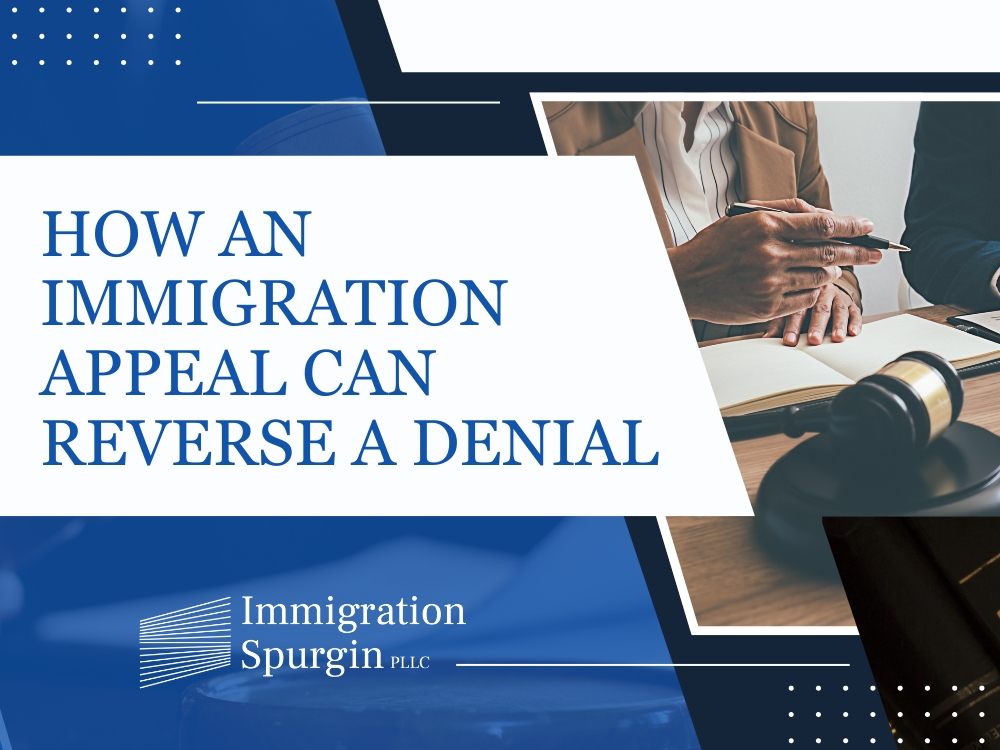U.S. immigration laws can feel overwhelming, especially when your application gets denied or delayed for further review. But don’t lose hope—appeals and motions can give you a second shot at reaching your immigration goals. The key is understanding how these processes work so you can move forward with confidence.
This guide explains everything you need to know about immigration appeals and motions, breaking down how they work and why professional legal representation is so important. With over 40 years of experience in immigration law, Immigration Spurgin PLLC has been a trusted resource for individuals and families navigating even the most challenging cases.
Don't risk your future by navigating the complexities of immigration on your own. Trust a professional to guide you through the process.
An immigration appeal is a legal process that allows you to challenge a decision made by U.S. immigration authorities, such as the denial of an application or petition. Filing an appeal provides an opportunity to have your case reviewed and reconsidered by a higher authority.

1. Receiving a Decision Notice
After your application or case is denied, you’ll receive a written decision from the appropriate authority, such as USCIS, ICE, or the immigration court. This document informs you of your right to appeal.
2. Filing the Notice of Appeal
Complete and submit the required forms (e.g., Form I-290B for USCIS decisions) within the specified timeframe, typically 30 days.
3. Providing Supporting Documentation
Along with your appeal, include additional evidence or legal arguments that address the reasons for denial.
4. Review Process by the Appellate Body
Depending on the case, appeals might be reviewed by agencies like the Board of Immigration Appeals (BIA) or the Administrative Appeals Office (AAO).
5. Issuance of a Decision
The appellate body will either uphold, overturn, or remand the initial decision, depending on its findings.
While appeals focus on escalating decisions to a higher authority, motions are filed with the original decision-maker to reconsider or reopen a case. Motions are often faster and more cost-effective than appeals, making them a popular option in many situations.
Motion to Reconsider
Filed when you believe the original decision was incorrect based on a misapplication of the law or policy. No new evidence is submitted.

Motion to Reopen
Filed when new facts or evidence become available that could significantly impact the outcome of the case.
Joint Motion to Reopen
Filed jointly with the government (e.g., Immigration and Customs Enforcement), typically in deportation or removal cases where the prosecutor agrees with reopening your case.
1. Identify the Basis for the Motion
Determine whether your case requires a motion to reconsider or reopen, based on the circumstances.
2. Prepare Documentation
For motions to reopen, gather and provide any new, relevant evidence. For motions to reconsider, focus on preparing strong legal arguments.
3. Submit on Time
Ensure all forms and supporting documents are filed with the right office within regulatory deadlines (usually 30 or 90 days from the date of decision).
4. Await a Decision
The original adjudicating authority will review the motion and either issue a new decision or maintain the original ruling.
The appeals and motions processes are intricate, with strict deadlines and legal nuances that can make or break a case. Working with a knowledgeable immigration appeal attorney ensures your rights are protected and your case is presented persuasively.
With over 40 years of experience, Immigration Spurgin PLLC has helped countless clients with immigration appeals, motions, and other complex immigration matters.
Whether you’re filing an immigration appeal or a motion, understanding the process and having experienced guidance is essential for success. Immigration Spurgin PLLC is dedicated to helping you overcome hurdles and move closer to achieving your dreams in the United States.
For personalized legal assistance, contact Immigration Spurgin PLLC and schedule a free consultation.
Call 915-233-6875 or fill out the form on our website to learn more.
